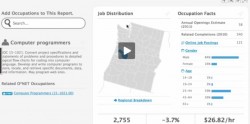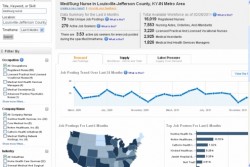It’s impossible to find an HR conference, a business magazine, or a recruiting site — especially this one — that isn’t talking about big data.
Just last month on ERE, Matthew Jeffery concluded his remarkable series on the future of recruiting — Recruitment 5.0 — saying “5.0 is all about… Personalization, self-sufficiency, predictability, big data, and back to basics.”
“Big Data,” he writes, “will become the central point of competition, driving productivity growth, innovation — and this applies to recruiting.”
Before big data can, as Kevin Wheeler put it a year ago, “change everything” about recruiting, recruiters will need to have access to it and know how to use it. Considering how few tap the full power of their own ATS, that’s a task on a par with getting PC users to see their first computer as more than just a word processor.
“Even if you have the tool,” says CareerBuilder’s Brent Rasmussen, “They don’t use it correctly; they don’t use it efficiently.”
Rasmussen wasn’t talking about anyone or group in particular; he was talking about the challenge of introducing a whole new way of dealing with information. In September, CareerBuilder bought employment and labor data and analytics firm EMSI (Economic Modeling Specialists International). It’s Rasmussen who has responsibility for integrating the EMSI data with CareerBuilder’s products, principally its Supply and Demand Portal.

Officially, Rasmussen is president of CareerBuilder North America. Think of him for the purposes of this article as CareerBuilder’s big data evangelist.
Before we go further, let me pause here to explain what it is EMSI and the Supply and Demand Portal do. In elevator pitch terms, they provide business professionals — from recruiters who source tough to fill jobs, to CEOs plotting business strategy — the kind of labor force information to make better decisions and be more competitive.
 On a tactical level, Supply and Demand and EMSI can tell a recruiter where the particular fish that is being sought is most plentiful. On a strategic level, the data can be used to help site new offices and plants, decide whether to hire or train, what the competition across town is paying, and how many workers there are with the specific skills a company needs.
On a tactical level, Supply and Demand and EMSI can tell a recruiter where the particular fish that is being sought is most plentiful. On a strategic level, the data can be used to help site new offices and plants, decide whether to hire or train, what the competition across town is paying, and how many workers there are with the specific skills a company needs.
Where Supply and Demand aggregates the millions of CareerBuilder resumes to provide a picture of supply, and the demand based on Wanted’s job posting data, EMSI supplements that with external labor information drawn from sources as varied as the U.S. Department of Labor and local employment services. EMSI was CareerBuilder’s external data vendor for the Supply and Demand Portal before it was bought.
Rasmussen says the EMSI acquisition has two major results. It opens the door to the C-suite, allowing CareerBuilder sales teams to demonstrate the strategic, competitive edge that big labor data can give a company. It also gives CareerBuilder a strategic recruiting tool to present to HR leaders.
I could talk here about the incredibly broad information that EMSI puts at your fingertips.
EMSI’s VP of Marketing Rob Sentz walked me through a demo of how a recruiting leader could use EMSI data to develop a hiring strategy. Not only will EMSI tell you how many workers with semiconductor manufacturing experience there are in Anytown, USA, but it will tell you how many of them are currently working, what the average pay is, providing you a sense of turnover and job availability. Not enough to meet your needs? EMSI will tell you how many workers there are in closely allied jobs that with a little training could fill your open reqs.
That’s just scratching the surface. There’s much more depth and detail available, even before it’s paired with the Supply and Demand Portal content. The challenge, then, is telling the story of what Big Data can do, and then getting HR professionals and recruiters to use it.
Rasmussen says that job falls now to his team. One way to make the Supply and Demand Portal a part of daily routine, he says, is to deliver the data. “We are pushing the data out of Supply and Demand based on what they (recruiters) told us they want to receive,” he said.
Sales reps monitor usage of the Supply and Demand dashboard, tailoring data delivery to user activity, and being proactive when customer usage slips. There’s also training on using the data, not just on how to use the system. And that’s strategic, not just its tactical use.
“If I can’t use it. It’s a waste of my time,” Rasmussen says as he again makes the point that CareerBuilder delivers — it doesn’t have to be retrieved — the data each user most wants.
There’s a second story to all this, and that is about the transformation of the job board industry. Only a few short years ago, CareerBuilder, its arch-rival Monster, and every other job site in the universe was where recruiters went to post a job opening and (sometimes) search the resumes. And it was where job seekers went to look and apply for jobs and post their resume.
Now CareerBuilder’s aggressive move to prop up HR’s strategic chops with Big Data, and Monster’s cloud-based semantic search product SeeMore, evidence the evolution of what used to be — and still shorthand is — called the job board industry.
“Reality is,” Rasmussen acknowledged during our call, “that we know we have to transform.”
He and presumably CareerBuilder, see the EMSI acquisition and the Supply and Demand Portal, as a big part of that transformation to, what? Call it a business intelligence company.
Overcoming the perception of the job board industry as a post-and-pray service that so many experts have all but written off won’t be easy, Rasmussen agreed. “We’re not going to change the perception and the articles (about the death of the job board) … with a billboard on the Kennedy (Expressway in Chicago, where CareerBuilder is headquartered).”
But having the data and showing how it can make a difference in winning the war for talent and the competitive battle for business and market share — now that will change not just the perception, but the very nature of the online career services industry itself.